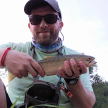Top 10 Fly Fishing Mistakes/Tips
A Beginner's Guide

We’ve all done it. You spend days and weeks (sometimes longer) waiting for a fishing trip or a weekend on the river with grand ideas of trout as fat as footballs. And then we hit the water…only to realize that we forgot a crucial piece of gear, left our lunch sitting on the kitchen counter, or god forbid, found someone else sitting in our fishing hole. Sometimes the only way to avoid these problems is to make sure they don’t happen in the first place. This is obviously easier said than done but, a small amount of preparation and pragmatic thought can set you up for success.
When I sat down to write this article I sent a text to my brother and asked him to come up with a list of his top 10 fly fishing mistakes...between the two of us we could have easily made it a “Top 25”. It was almost embarrassing to sit down and think of all the bonehead blunders we’ve made in the past, but it’s also important to learn from those mistakes.
The sad part is that no matter how long you have been fishing, you will still fall victim to some of these quagmires. The trick is to find a way to limit these bloopers and hopefully, remove some of the stress from an activity that is allegedly supposed to relax a person.
Number One: Do Your Homework –
We put this one at the top of the list for a reason. When it comes to a day of fly fishing, a little prep work can go a long way. There is a small amount of pre-work that should be done in the days leading up to a fishing trip that are very simple and often over looked. Always check the weather. Understanding what mother nature has in store will help you pack the right gear and be prepared for whatever hand she may deal you. It is also important to check water temperatures and flow rate (if possible). Not all rivers have published/updated data to show you this, but it is still important to consider. There is nothing worse than packing all of you gear and driving several hours to find out that river you had hoped to fish had turned to chocolate milk overnight. Again, this information isn’t always published online but it never hurts to call a local guide or fly shop to check. While you’ve got them on the phone, ask about flies. The guys and gals in the fly shops usually (but not always) have a good idea of what flies are working. Finally, read the regulations, especially if you are fishing new water. Don’t get caught trespassing or fishing with barbed hooks because you were too lazy to read the regs.
Number Two: Stick to the Plan –
It never hurts to have a plan in place, even if it is a loose one. Too often we have an idea in our mind of where we want to fish with no plan B. We pull into the turn out, put on our waders, rig up our gear and head down the bank only to find some inconsiderate jerk fishing our honey hole. The vast majority of us fish public water and it’s important to remember that, like it or not, we have to share. Have a handful of locations in mind so that if/when that happens you don’t spend all day behind the steering wheel hemming and hawing.
Number Three: Dress for the Occasion –
Having the right clothes for a given day can make or break a fishing trip. Cold mornings often turn into hot afternoons and you don’t want to be stuck sweating like a pig in long pants and wool socks. Layering your clothes is a great way to mitigate changing conditions, so take a second to think before you get dressed. Over time you will find out what types of materials you prefer in certain situations, but it never hurts to have options. Packing some extra clothes isn’t ever a bad idea. Also, don’t forget shades. It is easy to leave you sunglasses, sunscreen and hats and home when you are loading your gear at 5am, but there is nothing worse than roasting like a turkey because you forgot the SPF 30.
Number Four: Don’t be a Sucker –
When it comes to buying fly fishing gear there is a sucker born every minute. Don’t be that sucker. I have always believed that you get what you pay for and I think it is smart to buy quality gear…when necessary. Do some research and really decide what items are most important to you. At the end of the day a pair of nail clippers from CVS will do the same thing as a $40 pair of nippers from the fly shop. Fish don’t care that you blew your entire tax refund on overpriced gadgets, so spend your money on the things that are most important to you and save some dough on the rest.
Number Five: Know Your Knots –
Knots can be one of the toughest things for beginners to learn. Unless you were an Eagle Scout, you likely haven’t spent a whole lot of time learning and tying knots. You don’t need to be able to weave a Chinese finger trap out of 6x tippet, but you should know a handful of useful knots. Double surgeon, a clinch and a simple overhand loop are easy knots to learn and they can damn near solve any problem you might have on the water. Watch some videos and practice before you get out on the water because nothing is more frustrating than tying and retying knots on the bank of the river when the fish are humming.
Number Six: Limit Your Fly Choices –
I am more guilty of this fault than of any other and it consistently bites me in the ass. I think part of my issue is that I tie my own flies, so the supply is seemingly endless. What it typically means is that I change my fly pattern far too often instead of re-analyzing my approach. Sometimes it’s as simple and as moving a few steps up or down stream to adjust the drift and presentation of the fly. Don’t waste your time with an encyclopedia of fly patterns. Select your standard “go-to” patterns and mix in a few sleepers, but don’t spend all day staring at your fly box and expect to catch fish.
Number Seven: Get the Drift –
As the adage goes “practice makes perfect”. Its cliché, I know…but clichés are cliché for a reason. One of the biggest mistakes that we can make is throwing on our waders, rigging up our poles and making a b-line for the head of the run instead of taking the time to read the water. Slow down and pay attention to the entire run before you start slinging line. Secondly, many times we are so intensely focused on casting the fly that we forget to pay attention to the bug after it lands. Properly controlling the drift of the fly and mending line is just as important as fly choice and placement. Take the time to practice the drift.
Number Eight: Less is More –
You see a fish rise along the bank, so you adjust your cast and drift a fly perfectly across the spot with no hook up. So naturally, you go back for more…again and again and again. We tend to get tunnel vision on a specific “spot” and we become reluctant to assess the rest of the run. Eventually, we find ourselves recasting every 12 seconds to a patch of water the size of a basketball. Give the fly time to travel and give the fish time to react. You can’t catch fish if your fly isn’t in the water so sometimes less is more when it comes to casting.
Number Nine: Rip Lips –
FISH ON! This one also gets me. Giddy excitement can be the ultimate buzz kill. There is nothing more exciting (to me) than when a big fish takes a dry fly, and nothing more frustrating than when I rip it right out of his mouth seconds later. When it comes to trout, we don’t have to punch our hook straight through its snout to get them in the net. A trout’s mouth is relatively soft, and a relatively light hook set will do the trick most of the time. You will often find that an overzealous hook set results in lost fish and lost flies. When you see that rise take a breath and firmly raise your rod.
Number Ten: Immediate Results –
Last but not least, remain realistic. It’s always important to remember why we’re are on the water in the first place. Of course, we like to catch fish, but there is more to it than that. Some of us fish to relax, relieve stress, reconnect with nature…blah blah blah. Whatever the goal, we must understand that fishing takes patience. If your expectation is to have gold medal days every time you thread the eye you will likely end up sitting on the bank sulking. We aren’t going to catch fish every time we go out but that’s why we bring beer. Keep your predictions in check and do your best to be patient.
Like I said, this could easily have been a “top 25” list but, for the sake of brevity, we decided to spare you (and our egos) from a rambling tirade. Hopefully you learned something. Remember, at the end of the day, a little preparation can make all the difference. Good luck and good fishing!
About the Creator
Sam Lavigne
I am a hunter, fisherman and father living in the Pacific Northwest. Most of my writing is related to one or all of those things. I hope you enjoy!






Comments
There are no comments for this story
Be the first to respond and start the conversation.